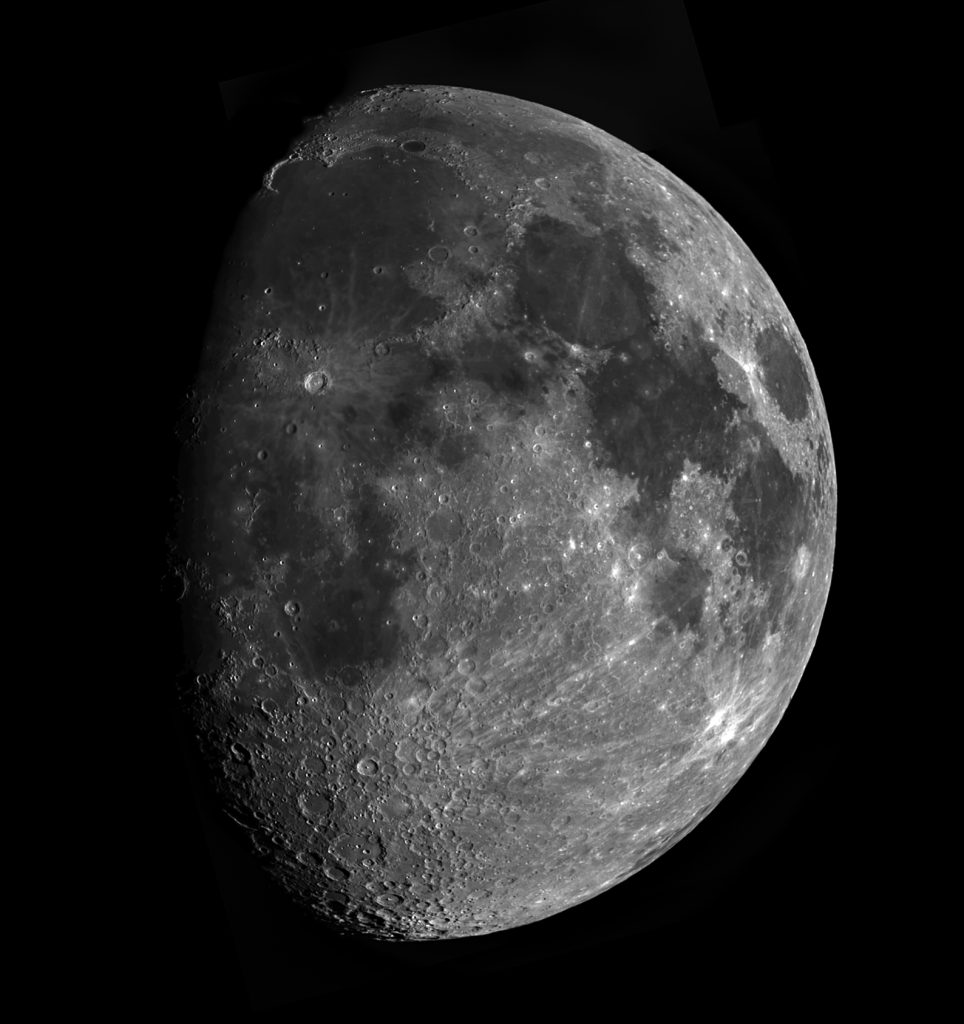APRIL 2021
Lunar Imaging with the Altair Astro Hypercam 294c PRO TEC camera
[This is just one of many articles in the author’s Astronomy Digest.]
I bought the AA 294c for use as a cooled deep sky imager –as covered in the article ‘Springtime Galaxies’ in the Digest. However, AA state that ‘for lunar andplanetary imaging, at long focal lengths, the 294C is quite a formidable solarsystem camera’ and suggest that it would be particularly suitablefor use with long focal length telescopes. I thought that this was worth pursuing and decided to couple it to my300 mm, f/9, (so 2,700 mm focal length) Orion Optics (UK) sub-aperture Maksutovin order to image the Moon. This is aninteresting design using a spherical primary mirror with a corrector lensplaced in front of the secondary mirror so that the light passes through ittwice. The telescope is thus open so thetelescope will cool down faster and there is no corrector plate to dew up. It is even equipped with a dew heater for thesecondary mirror/corrector lens assembly and has a motor driven focuser whichis exceedingly useful. Weighing some 29lbs, it requires the use of a very sturdy mount and, due to its size, issensitive to wind gusts.

There is some discussion as to what is theoptimum sized aperture telescope to use for lunar or planetary imaging. A large aperture telescope is ‘seeing’through a larger column of the atmosphere and this can actually reduce theresolution achieved. On the other hand,the fundamental resolution of a 300 mm aperture will, at ~0.46 arc seconds, notmaterially affect the overall resolution that can be achieved and the greaterlight gathering power will reduce the exposure time so helping to capture theMoon or planets during the very brief moments when the atmosphere along the line of sight is calm. The renowned planetary imager, Damian Peach,has said that apertures up to 9.25 inches such as the Celestron Schmidt-Cassegraincan be sensibly used under UK skies but he has produced stunning images of theplanets using a 14 inch S-C in perfect seeing conditions in Barbados. [I think my highest resolution lunar imagehas been captured using a Vixen VC200L, 200 mm aperture, catadioptric telescopeas is described in the digest article ‘High resolution Lunar Imaging with theVixen VC200L’.]
The French astronomer, Thierry Legault, hasachieved some superb resolution lunar images (I suspect the world’s best) usinga Celestron C14 Edge HD from a height of 2,800 m in France. He was taking videosequences using the ZWO ASI1600MM camera having a 16 megapixel sensor which onlyrequired 10 panes to cover the lunar disk. His image spans over 13,600 pixels in height and, I suspect, has aresolution of 0.25 to 0.3 arc seconds and appears to be solely limited by thetelescope’s resolution – the effects of the atmosphere having been totallyeliminated.
The AA 294c has a similar sensor size tothat used by Thierry Legault. It has fewer and larger pixels than the ZWO ASI1600MM but a higherdynamic range. When used with a 2,700focal length telescope, each pixel subtends ~0.3 arc seconds, so could achievethe Nyquist sampling theorum requirement if the atmosphere limits theresolution to 0.7-1 arc seconds. So it isideal for use with this telescope. [As the frames of the video sequences areonly captured with a 8-bit depth, the dynamic range has no effect.]
Imaging the 10 day old waxing gibbous Moon.
This, I think, is one of the most beautiful phases of the Moon; the great craters, Tycho and Copernicus, show up well and, in particular, I love the circular arc of mountains partly surrounding ‘Sinus Iridum’, the Bay of Rainbows.
On the night of the 22nd April 2021, I was ableto image the Moon almost due south at an elevation of ~50 degrees – about ashigh in elevation as it gets from the UK. The seeing was excellent and it was totally calm so the mount’s trackingwas unaffected by any breeze. Due to thelarge sized sensor the capture rate was just 13 frames per second with eachframe having an exposure of 10 milliseconds. However this meant that only 6 panes were needed to cover the Moon’ssurface with sufficient overlap to allow them to be composited into the fulldisk image. Several sequences weretaken. That used was the last sequence(when the sky was darkest so giving the greatest contrast) and ~1,000 frameswere taken to produce each pane.
The .avi video sequences were aligned and stacked in Autostakkert! and loaded into Microsoft ICE (Image Composite Editor). Sadly this no longer seems to be available for download.

This produced a full disk image.

The resulting full disk image was sharpened using the ‘Richardson-Lucy’ deconvolution sharpening tool in the, now free, Images Plus software package.
The full disk image was 5,672 pixels across. That night the Moon subtended 1,933 arcseconds across, so each pixel subtended 0.29 arc seconds. This is obviously ‘sampling’ the imagewell. Judging from the smallest spotsize I can find in the image, I judge that the resolution of the image was oforder 1 arc second – about the best that I could have hoped for.
As the image cannot be shown at full resolution, here are some crops to give some idea of the image quality. I do think that the results show that the AA 294c makes a very formidable lunar and planetary webcam and, for planetary imaging, the area of the frame used can be reduced to increase the capture rate.



